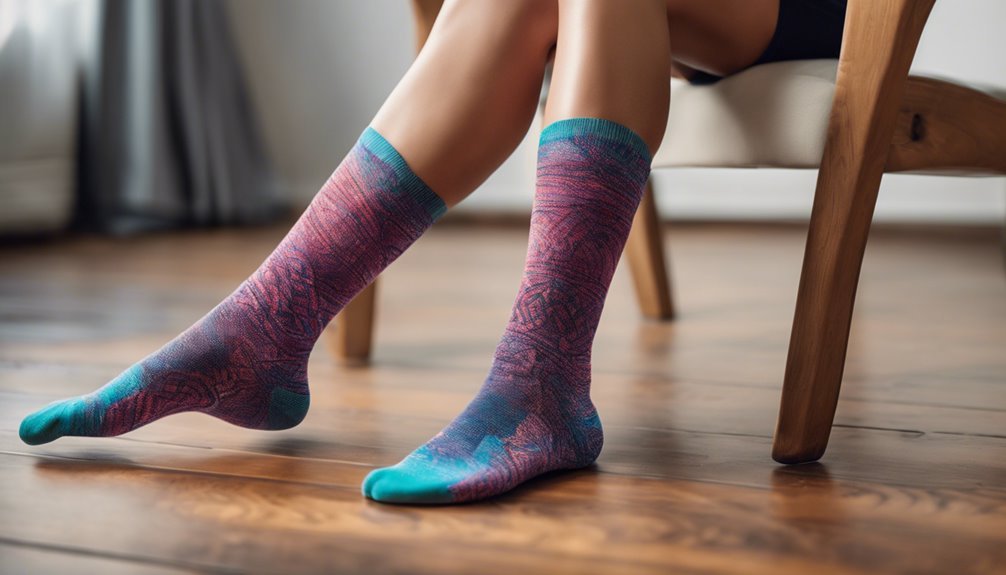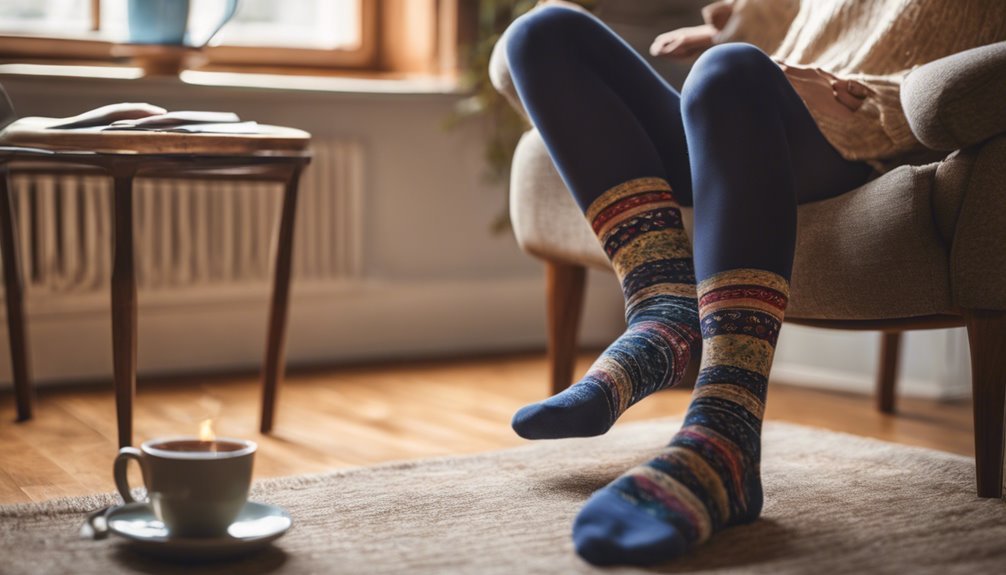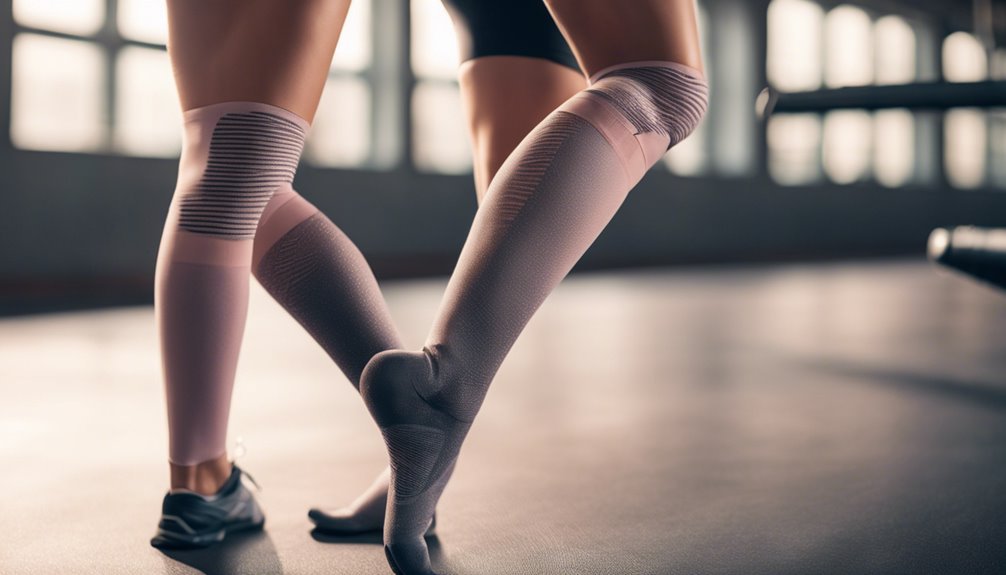How Compression Socks Improve Circulation
Compression socks improve circulation by applying graduated pressure to your legs, which enhances venous return. This pressure supports your veins, helping blood flow efficiently back to your heart and reducing pooling in the lower extremities. As a result, you may experience reduced swelling and discomfort while benefiting from increased oxygen delivery to your muscles. Athletes and those with sedentary lifestyles particularly find these effects beneficial. Explore more about the specific benefits and how to choose the right level for your needs.
Understanding Compression Socks: What They Are and How They Work

Compression socks are specialized garments designed to enhance blood circulation in the legs. They come in various compression sock types, each tailored for specific needs. For instance, graduated compression socks apply varying levels of pressure, promoting blood flow from the ankles to the thighs. You may find knee-high, thigh-high, or full-leg options, depending on your medical uses. Athletes often use compression socks to reduce muscle soreness and enhance performance, while those with medical conditions like varicose veins or deep vein thrombosis may wear them to prevent complications. Understanding these types and their benefits can empower you to make informed choices about your circulation health, allowing you the freedom to engage in activities you love without discomfort.
The Science Behind Circulation and Compression
Understanding how blood circulation works is key to appreciating the role of compression socks in enhancing it. Your body relies on effective venous return to transport deoxygenated blood back to the heart. When you wear compression socks, they apply graduated pressure on your legs, which helps improve this venous return. This pressure supports the veins, making it easier for blood to flow upward, reducing the chance of blood pooling and promoting better arterial health. Enhanced circulation not only alleviates discomfort but also aids in nutrient delivery and waste removal. By optimizing blood flow dynamics, compression socks serve as a practical tool for maintaining your freedom of movement while ensuring your vascular system functions efficiently.
Benefits of Improved Circulation With Compression Socks
Wearing compression socks can greatly enhance blood flow in your legs, promoting better circulation. This improvement often leads to reduced swelling, which can alleviate discomfort and enhance overall mobility. Understanding these benefits can help you make informed choices about your health and wellness.
Enhanced Blood Flow
Numerous studies have shown that enhanced blood flow is one of the primary benefits of using compression socks. By applying graduated pressure to your legs, these socks help to improve blood vessel health, promoting efficient circulation. This increased blood flow delivers more oxygen and nutrients to your muscles, which can markedly enhance athletic performance. Whether you're running a marathon or just standing for extended periods, improved circulation can reduce fatigue and boost your endurance. Additionally, better blood flow helps in quicker recovery post-exercise, allowing you to maintain your active lifestyle without unnecessary setbacks. So, if you're seeking freedom in movement and performance, incorporating compression socks into your routine could be a game-changer for you.
Reduced Swelling Effects
Improved circulation not only enhances blood flow but also considerably contributes to reducing swelling in the legs and feet. When you wear compression socks, they apply graduated pressure, which helps prevent the accumulation of fluid in your lower extremities. This not only leads to reduced discomfort but also promotes enhanced mobility, allowing you to move freely and engage in daily activities without the burden of swelling. Studies have shown that individuals who use compression socks report significant improvements in their overall comfort and functionality. By effectively managing swelling, these socks can help you maintain an active lifestyle, ensuring you enjoy the freedom of movement you desire while minimizing the risks associated with poor circulation.
Choosing the Right Compression Level for Your Needs
When you're selecting compression socks, understanding the various compression levels is essential for meeting your specific needs. Factors such as your activity level, health conditions, and intended use can greatly influence your choice. Knowing these elements will help you select the right level of compression for ideal support and comfort.
Understanding Compression Levels
Choosing the right compression level for your needs is essential, as it directly impacts the effectiveness of the socks in promoting circulation. Compression levels are defined by the pressure gradient they exert on your legs, which helps improve blood flow. Here's a quick reference to help you choose the right level:
| Compression Level | Pressure Gradient (mmHg) |
|---|---|
| Mild | 8-15 mmHg |
| Moderate | 15-20 mmHg |
| Firm | 20-30 mmHg |
| Extra Firm | 30-40 mmHg |
Understanding these levels can empower you to select the appropriate socks based on your lifestyle and health needs. Always consult a healthcare professional if you're unsure about which compression level is best for you.
Factors Influencing Choice
Several factors can influence your choice of compression level, ensuring the socks meet your specific needs. Here are three key aspects to take into account:
- Compression Level: Determine the required pressure (measured in mmHg) based on your activity and health condition.
- Fabric Types: Choose from materials like nylon or spandex, which can offer breathability and comfort during wear.
- Sizing Options: Accurate sizing is essential; measure your legs to find the right fit, as improper sizing can negate the benefits of compression.
Who Can Benefit From Wearing Compression Socks?
While many people can benefit from wearing compression socks, certain groups may find them particularly advantageous. Athletes, for instance, can experience enhanced performance and quicker recovery, as these socks promote blood flow and reduce muscle fatigue. If you're an athlete, incorporating compression socks into your routine can help minimize soreness and improve endurance. Pregnant women also stand to gain significant advantages. As your body undergoes changes, compression socks can alleviate swelling and discomfort in your legs, promoting better circulation and reducing the risk of varicose veins. By understanding these benefits, you can make informed choices that support your overall health and well-being, allowing you to feel more comfortable and active throughout your daily life.
Tips for Incorporating Compression Socks Into Your Daily Routine

Incorporating compression socks into your daily routine can be seamless if you follow a few simple strategies.
- Choose the Right Time: Wear them during activities that require prolonged standing or sitting, like working at a desk or traveling.
- Start Gradually: If you're new to daily wear, begin with a few hours each day and increase the duration as your body adjusts.
- Pair with Your Lifestyle: Incorporate them with your daily activities, like exercising or running errands, to enjoy enhanced circulation throughout the day.
Frequently Asked Questions
Can Compression Socks Be Worn While Sleeping?
You can wear compression socks while sleeping for potential benefits like improved circulation and nighttime comfort. However, it's important to choose the right level of compression and consult a healthcare professional to guarantee safety.
Are There Any Side Effects of Wearing Compression Socks?
Wearing compression socks can feel like a warm embrace, yet improper usage guidelines might lead to side effects like skin irritation or discomfort. Always consult a professional to guarantee you're maximizing benefits while minimizing risks.
How Long Should I Wear Compression Socks Each Day?
You should aim for a daily duration of 8 to 12 hours when wearing compression socks. Following these wearing guidelines helps guarantee ideal support and comfort while minimizing potential side effects associated with prolonged use.
Can I Wear Compression Socks if I Have Diabetes?
If you're managing diabetes, wearing compression socks can enhance blood circulation. For instance, Sarah found relief from swelling while maintaining her active lifestyle, showcasing how they can be beneficial when used correctly in diabetes management.
Do Compression Socks Come in Different Styles and Colors?
Yes, compression socks come in various styles and colors, offering you diverse fashion options. They're made from different material types, ensuring comfort and effectiveness, allowing you to express your style while enjoying their benefits.







